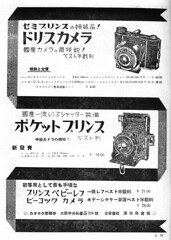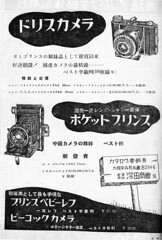Pocket Prince
The Pocket Prince is a Japanese folding camera taking 4×6.5 pictures on 127 film, advertised in 1939 and 1940 by the distributor Fukada Shōkai.[1]
Contents
Description
The Pocket Prince is a vertical folder copied from the Agfa Billy Zero. The metal struts have a curved slot guiding the front standard when folding the bed. There is a folding frame finder in the middle of the top plate. The key to wind the film is at the bottom right, as seen by a photographer holding the camera horizontally. Variations are known in the position of the folding bed release, which is either next to the advance knob or on the opposite side. The back is hinged to the left and contains a single uncovered red window in the middle, with a hexagonal shape, the same as on the Billy 0. The camera was available with various lens and shutter combinations, discussed in the next sections.
Manufacturer
The Pocket Prince is usually attributed to Fujimoto,[2] as other cameras with the Prince brand, but this is not confirmed by any original document. Other sources attribute the camera to "Prince Camera Works",[3] but this was not the name of any actual company, only a dummy name used for promotional purpose (see Camera Works).
The Speed Pocket made from 1936 by Kuribayashi and distributed by Minagawa is extremely similar to the Pocket Prince, but has provision for 3×4cm exposures and decorative patterns on the top and bottom plates and on the standing leg. The two cameras are perhaps related, and Kuribayashi maybe worked as a subcontractor for Fukada.
Commercial life
The Pocket Prince was advertised in Asahi Camera from August 1939 to October 1940.[4] In the October 1939 advertisement, the camera is announced as a new product, along with various other models distributed by Fukada.[5] The lens and shutter is not specified, but the picture shows a Radionar lens and Prontor II shutter. (This picture was reused on later advertisements, and is reproduced in this page.) It is said that the camera was available with a Radionar f/4.5 and either the Prontor II or a Compur.[4]

|

|
| April 1940 | May 1940 |
| Advertisements in Asahi Camera. (Image rights) | |
The advertisements dated April and May 1940, reproduced above, show the Pocket Prince and Doris (3×4).[6] The Pocket Prince is offered for ¥58 with a Baron 75/4.5 lens and a Kerio shutter (25, 50, 100, 150, T, B). The August 1940 advertisement gives the same information.[7]
In the official list of set prices compiled in October 1940 and published in January 1941, the Pocket Prince is listed for ¥69, with no further detail.[8] This is the last mention of the camera found in the original documents.
Actual examples
One example is pictured in Sugiyama with a Prontor II shutter (175–1, B, T) and a Schneider Radionar 7.5cm f/4.5 lens.[9] On that particular example, the folding bed release is placed next to the advance key. There is a black accessory shoe at the right end of the top plate, which is probably not original.
Another camera is identified as a Speed Pocket in various sources.[10] This identification is very unlikely and the camera is certainly a Pocket Prince. It has none of the distinguishing features of the Speed Pocket: "art-deco" patterns on the top and bottom plates and on the standing leg, and SPEED brand embossed at the front. Furthermore, it has a Baron Anastigmat 7.5cm f/4.5 lens in a Kerio shutter, just like the Pocket Prince. On this camera, the folding bed release is on the same side as the viewfinder — this configuration is the same as on the picture displayed in the advertisements.
Notes
- ↑ Dates: Kokusan kamera no rekishi, p.340.
- ↑ Sugiyama, item 1233, and McKeown, p.331.
- ↑ Kokusan kamera no rekishi, p.340.
- ↑ 4.0 4.1 Kokusan kamera no rekishi, p.340.
- ↑ Advertisement reproduced in Kokusan kamera no rekishi, p.91.
- ↑ Advertisements in Asahi Camera April 1940, p.A56, and May 1940, p.A29. That dated April is reproduced in Kokusan kamera no rekishi, p.80.
- ↑ Advertisement reproduced in Kokusan kamera no rekishi, p.80.
- ↑ "Kokusan shashinki no kōtei kakaku", type 2, section 6B.
- ↑ Example pictured in Sugiyama, item 1233.
- ↑ Example pictured in Sugiyama, item 1052, Baird, pp.99–101 of Kuribayashi-Petri Cameras, McKeown, p.577 and Lewis, p.51.
Bibliography
Original documents
- Asahi Camera. Advertisements by Fukada Shōkai:
- April 1940, p.A56;
- May 1940, p.A29.
- "Kokusan shashinki no kōtei kakaku" (国産写真機の公定価格, Set prices of the Japanese cameras), listing Japanese camera production as of October 25, 1940 and setting the retail prices from December 10, 1940. Published in Asahi Camera January 1941 and reproduced in Shōwa 10—40nen kōkoku ni miru kokusan kamera no rekishi (昭和10〜40年広告にみる国産カメラの歴史, Japanese camera history as seen in advertisements, 1935—1965). Tokyo: Asahi Shinbunsha, 1994. ISBN 4-02-330312-7. Pp.108—9. Type 2, section 6B.
Recent sources
- Asahi Camera (アサヒカメラ) editorial staff. Shōwa 10–40nen kōkoku ni miru kokusan kamera no rekishi (昭和10–40年広告にみる国産カメラの歴史, Japanese camera history as seen in advertisements, 1935–1965). Tokyo: Asahi Shinbunsha, 1994. ISBN 4-02-330312-7. Item 230. (See also the advertisements for item 155.)
- Baird, John R. Collectors guide to Kuribayashi-Petri Cameras. Grantsburg, WI (USA): Centennial Photo Service, 1991. ISBN 0-931838-16-9. Pp.99–101.
- Lewis, Gordon, ed. The History of the Japanese Camera. Rochester, N.Y.: George Eastman House, International Museum of Photography & Film, 1991. ISBN 0-935398-17-1 (paper), 0-935398-16-3 (hard). P.51.
- McKeown, James M. and Joan C. McKeown's Price Guide to Antique and Classic Cameras, 12th Edition, 2005-2006. USA, Centennial Photo Service, 2004. ISBN 0-931838-40-1 (hardcover). ISBN 0-931838-41-X (softcover). Pp.331 and 577.
- Sugiyama, Kōichi (杉山浩一); Naoi, Hiroaki (直井浩明); Bullock, John R. The Collector's Guide to Japanese Cameras. 国産カメラ図鑑 (Kokusan kamera zukan). Tokyo: Asahi Sonorama, 1985. ISBN 4-257-03187-5. Items 1052 and 1233.
